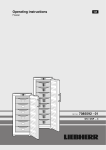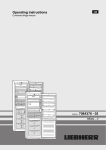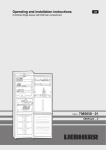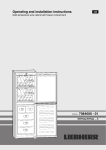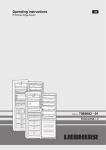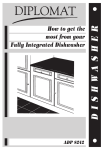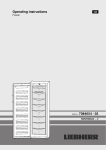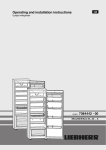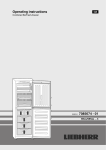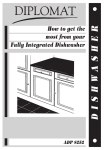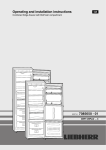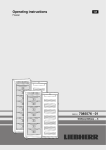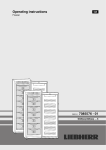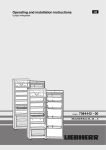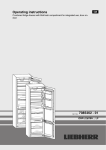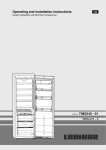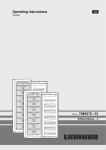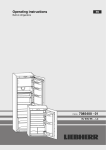Download Operating and installation instructions 210514 - Andi
Transcript
Operating and installation instructions Multi-temperature wine cabinet with freezer compartment 210514 7084680 - 01 SWTNes/WTNes ... 6 Appliance at a glance Contents 1 1.1 1.2 1.3 1.4 1.5 1.6 Appliance at a glance............................................ Description of appliance and equipment.................. Range of appliance use............................................ Conformity................................................................ External dimensions of the appliance....................... Saving energy.......................................................... HomeDialog............................................................. 2 2 2 3 3 3 3 2 General safety information................................... 3 3 3.1 3.2 Controls and displays........................................... Operating and control elements............................... Temperature display................................................. 5 5 5 4 4.1 4.2 4.3 4.4 4.5 4.6 4.7 4.8 Putting into operation............................................ Transporting the appliance....................................... Installing the appliance............................................. Changing over the door hinges................................ Water connection..................................................... Insertion into a row of kitchen units........................... Disposing of packaging............................................ Connecting the appliance......................................... Switching on the appliance....................................... 5 5 5 6 10 11 11 11 11 5 5.1 5.2 5.3 5.4 5.5 5.6 Control.................................................................... Brightness of the temperature display...................... Child proofing........................................................... Door alarm................................................................ Temperature alarm................................................... Freezer compartment............................................... Wine zone................................................................ 12 12 12 12 12 12 14 6 6.1 6.2 6.3 6.4 6.5 Maintenance........................................................... Replacing the activated charcoal filter...................... Defrosting with NoFrost............................................ Cleaning the appliance............................................. Cleaning the IceMaker............................................. Customer service..................................................... 15 15 15 16 16 16 7 Malfunction............................................................. 17 8 8.1 8.2 Decommissioning.................................................. 18 Switching off the appliance....................................... 18 Taking the appliance out of service.......................... 18 9 Disposing of the appliance................................... 18 The manufacturer works constantly on the further development of all the types and models. Therefore please understand that we have to reserve the right to make design, equipment and technical modifications. To get to know all the benefits of your new appliance, please read the information contained in these instructions carefully. The instructions apply to several models. Differences may occur. Text relating only to specific appliances is marked with an asterisk (*). Instructions for action are marked with a action are marked with a . , the results of 1 Appliance at a glance 1.1 Description of appliance and equipment Note u Shelves, drawers and baskets are arranged for optimum energy efficiency on delivery. 2 (1) Control panel (2) LED lighting (3) Activated charcoal filter, replaceable (4) Wooden shelf, folding (5) Label (6) Wooden shelf, fixed (7) Separating plate with sealing lip (8) Type plate Fig. 1 (9) IceMaker (10) Freezer compartment (11) Cold storage accumulators (12) VarioSpace (13) Information system (14) Adjustable feet (15) Transport grips 1.2 Range of appliance use Intended use The appliance is suitable solely for cooling wine and food in a domestic environment or similar. This includes use in, for example - in staff kitchenettes, bed and breakfast establishments, - by guests in country cottages, hotels, motels and other accommodation, - for catering and similar services in the wholesale trade. Use the appliance solely in a domestic type of environment. All other applications are inadmissible. Foreseeable misuse The following applications are expressly prohibited: - Storage and cooling of medicines, blood plasma, laboratory compounds or similar * Depending on model and options General safety information materials and products subject to the Medical 1.4 External dimensions of the appliDevices Directive 2007/47/EC ance - Use in potentially explosive areas Improper use of the appliance can lead to damage to or spoilage of the stored goods. Climate rating definitions The appliance is set to operate within specific ambient temperature limits according to its climate rating. The correct climate rating for your appliance is indicated on the type plate. Note uCompliance with the ambient temperatures indicated is required, otherwise the cooling performance is reduced. Climate rating for ambient temperatures of SN 10 °C to 32 °C N 16 °C to 32 °C ST 16 °C to 38 °C T 16 °C to 43 °C Fig. 2 1.3 Conformity 1.5 Saving energy The refrigerant circuit is tested for leakage. The appliance complies with the relevant safety regulations and EC Directives 2006/95/EC, 2004/108/EC, 2009/125/EC and 2010/30/EU. - Always ensure good ventilation. Do not cover ventilation Note for test institutions: Tests are to be carried out according to the applicable standards and guidelines. Preparation and testing of the appliances must be carried out taking the manufacturer's loading plans and the notes in the operating manual into account. openings or grille. - Always keep fan louvres clear. - Do not place appliance in areas of direct sunlight or next to a stove, heater or similar object. - The energy consumption depends on the installation conditions, e.g. the ambient temperature (see 1.2) . - Keep the time the appliance is open to a minimum. - The lower the temperature setting, the higher the power consumption. Accumulated dust increases the energy consumption: - Once a year, dust the refrigerating unit together with the metal grille of the heat exchanger at the back of the appliance. 1.6 HomeDialog Depending on model and options, the HomeDialog system can be used to network a number of Liebherr appliances (situated, for example, in the basement) with a main appliance (sited, for example, in the kitchen) and control them via the latter. You will find more information on the benefits, requirements and principle of operation on the internet at www. liebherr.com. 2 General safety information Danger for the user: - This appliance can be used by children of 8 years old and over, and also by persons with restricted physical, sensory or mental capacity or lack of experience and knowledge, if they are supervised or have been * Depending on model and options 3 General safety information instructed on safe use of the appliance and understand the resulting risks. Children must not be allowed to play with the appliance. Cleaning and user maintenance must not be carried out by children without supervision. - When disconnecting the appliance from the supply, always take hold of the plug. Do not pull the cable. - In the event of a fault pull out the mains plug or deactivate the fuse. - Do not damage the mains power cable. Do not operate the appliance with a defective mains power cable. - Have any repairs to or intervention in the appliance, and any change of the mains power cable, carried out by the customer service only or by other specialised personnel trained for the purpose. - Only assemble, connect and dispose of the appliance according to the instructions. - Please keep these instructions in a safe place and pass them on to any subsequent owners. - All repairs to and intervention in the IceMaker may be carried out only by service personnel or by other skilled personnel trained for the purpose. - The manufacturer is not liable for damage caused by a faulty fixed water connection. - Special-purpose lamps (incandescent lamps, LEDs, fluorescent tubes) in the appliance serve to illuminate the appliance interior and are not suited for room illumination. Fire hazard: - The refrigerant R 600a is environmentally friendly but flammable. Escaping refrigerant may ignite. • Do not damage the refrigerant circuit pipes. • Do not allow naked flames or ignition sources to enter the appliance. • Do not use any electrical appliances in the interior (e.g. steam cleaners, heaters, ice cream maker etc.). • If refrigerant escapes: remove any naked flames or sources of ignition from the leakage area. Ventilate the room well. Notify the after-sales service. - Do not store explosives or sprays using combustible propellants such as butane, propane, pentane, etc. in the appliance. To identify these spray cans, look for the list of contents printed on the can, or a flame symbol. Gases possibly escaping may ignite due to electrical components. - Keep burning candles, lamps and other items with naked flames away from the appliance so that they do not set the appliance on fire. 4 - Please be sure to store alcoholic drinks or other packaging containing alcohol in tightly closed containers. Any alcohol that leaks out may be ignited by electrical components. Danger of tipping and falling: - Do not misuse the plinth, drawers, doors etc. as a step or for support. This applies particularly to children. Danger of food poisoning: - Do not consume food which has been stored too long. Danger of frostbite, numbness and pain: - Avoid lasting skin contact with cold surfaces or refrigerated/frozen food or take protective steps, e.g. wear gloves. Do not consume ice cream, water ice or ice cubes immediately and do not consume them too cold. Danger of injury and damage: - Hot steam can lead to injury. Do not use electrical heating or steam cleaning equipment, open flames or defrosting sprays to defrost. - Do not use sharp implements to remove the ice. Risk of crushing - Do not reach into the soft stop mechanism. Fingers may be trapped when the door is closed.* Please observe the specific information in the other sections: DANGER identifies a situation involving direct danger which, if not obviated, may result in death or severe bodily injury. WARNING identifies a dangerous situation which, if not obviated, may result in death or severe bodily injury. CAUTION identifies a dangerous situation which, if not obviated, may result in minor or medium bodily injury. NOTICE identifies a dangerous situation which, if not obviated, may result in damage to property. Note identifies useful information and tips. * Depending on model and options Controls and displays 3 Controls and displays 4 Putting into operation 3.1 Operating and control elements 4.1 Transporting the appliance Fig. 3 (1) Alarm button (2) SuperFrost button (3) On/Off button, freezer compartment (4) Down setting button, freezer compartment (5) Up setting button, freezer compartment (6) IceMaker symbol (7) Temperature display, lower wine zone (8) Temperature display, upper wine zone (9) Upper wine compartment symbol (10) Light symbol (11) Power failure symbol (12) Down setting button, wine zone (13) Up setting button, wine zone (14) On/Off button, wine zone (15) Zone button (16) Light button (17) Fan button (18) Child lock symbol (19) Fan symbol (20) Menu symbol (21) HomeDialog symbol (22) Lower wine compartment symbol (23) Freezer compartment temperature display (24) SuperFrost symbol (25) Alarm symbol 3.2 Temperature display The following are displayed in normal operation: - the average wine cabinet temperature - the warmest freezing temperature The freezer compartment temperature display flashes: - the temperature setting is being changed - after switch-on the temperature is not yet cold enough - the temperature has risen several degrees The wine zone temperature display flashes: - the temperature setting is being changed - after switch-on until the set temperature is reached - the wine cabinet temperature is too cold/too warm Dashes flash in the display: - the freezer temperature is above 0 °C. The following displays indicate malfunction. Possible causes and corrective action (see Malfunction). - F0 to F9 - FE - The LED of the power failure symbol CAUTION Risk of injury and danger of damage as a result of incorrect transport! u Transport the appliance in a packed condition. u Transport the appliance upright. u Do not transport the appliance without assistance. WARNING Risk of injury due to broken glass! In case of transport at an altitude of over 1500 m the glass panes of the door may break. The fragments have sharp edges and may cause serious injury. u Take appropriate protective action. 4.2 Installing the appliance WARNING Fire hazard due to dampness! If live parts or the mains lead become damp this may cause short circuits. u The appliance is designed for use in enclosed areas. Do not operate the appliance outdoors or in areas where it is exposed to splash water or damp conditions. WARNING Risk of fire due to short circuit! If the mains cable/connector of the appliance or of another appliance touch the rear of the appliance, the mains cable/ connector may be damaged by the appliance vibrations, leading to a short circuit. u Stand the appliance so that it is not touched by connectors or main cables. u Do not plug the appliance or any others into sockets located near the rear of the appliance. WARNING Fire hazard due to refrigerant! The refrigerant R 600a is environmentally friendly but flammable. Escaping refrigerant may ignite. u Do not damage the piping of the refrigeration circuit. WARNING Fire hazard and danger of damage! u Do not place appliances emitting heat e.g. microwaves, toasters etc. on the appliance! flashes. WARNING Blocked ventilation openings pose a risk of fire and damage! u Always keep the ventilation openings clear. Always ensure that the appliance is properly ventilated! * Depending on model and options 5 Putting into operation NOTICE* Risk of damage due to condensate! If your appliance is not a Side-by-Side (SBS) appliance: u do not install the appliance directly alongside a further refrigerator/freezer. q In the event that the appliance is damaged, contact the supplier immediately before connecting to the mains. q The floor at the site must be flat and level. q Do not install the appliance in a location where it is exposed to direct radiation of the sun, next to a cooker, heater and similar. q The appliance may be moved only when it is empty. q Do not install the appliance without assistance. q The more R 600a refrigerant there is in the appliance, the larger the room in which the appliance is standing needs to be. In rooms that are too small, a flammable mix of gas and air may be created if there is a leak. According to the EN 378 standard, every 11 g of R 600a refrigerant requires at least 1 m3 space in the room for the appliance. The amount of refrigerant in your appliance is on the type plate inside the appliance. u Detach the connecting cable from the rear of the appliance, removing the cable holder at the same time because otherwise there will be vibratory noise! u Remove the protective film from the outside of the appliance. 4.3 Changing over the door hinges You can change over the door hinges if necessary. NOTICE Risk of damage to side-by-side appliances due to condensation! When a side-by-side appliance (S…) is fitted together with a second appliance (as a SBS combination), the door hinges must remain as delivered. u Do not change over the door hinges. Ensure that the following tools are to hand: q Torx® 25 q Torx® 15 q Screwdriver q Cordless screwdriver, if necessary q Second person for fitting work, if needed q Accompanying Allen key size 2* 4.3.1 Detaching the upper soft stop mechanism NOTICE The stainless steel doors are provided with a high-quality surface coating and must not be treated using the accompanying care product. Otherwise the surface coating will be affected. u Wipe the coated door surfaces using a soft, clean cloth only. u Apply a stainless steel cleaner only to the stainless steel side walls evenly, wiping with the grain. Subsequent cleaning becomes easier as a result. u Wipe side walls with a paint finish using a soft, clean cloth only. u Remove the protective film from the decorative trims and drawer fronts. u Remove all transit supports. u Dispose of packaging material (see 4.6) . u Align the appliance so that it stands firmly and on a level by applying the accompanying spanner to the adjustableheight feet (A) and using a spirit level. u Then support the door: Extend the adjustable foot at the turn hinge (B) until it rests on the floor and then make a further 90° turn.* When a Side-by-Side appliance (S…) is fitted together with a second appliance (as a SBS combination): u Proceed according to the Side-by-Side combined fridgefreezer installation instructions. (Accessories bag of the SBS freezer/appliance with freezer compartment)* Note u Clean the appliance (see 6.3) . If the appliance is installed in a very damp environment, condensate may form on the outside of the appliance. u Always see to good ventilation at the installation site. 6 Fig. 4 u Open the upper door. NOTICE Risk of damage! If the door seal is damaged, the door may fail to close properly and the cooling will be inadequate. u Do not damage the door seal with the screwdriver! u Disengage and remove the faceplate Fig. 4 (1) using a flatblade screwdriver. w The faceplate is attached over the soft stop bracket. Fig. 5 u Slide the faceplate forwards over the soft stop bracket Fig. 5 (4) in the direction of the appliance. u Snap the safety lock Fig. 5 (2) into the oblong hole. w The safety lock prevents the hinge from snap-closing. u Using a screwdriver, detach the cover Fig. 5 (5) on the hinge side as far as the first detent. w The pin becomes visible. * Depending on model and options Putting into operation u Press the pin Fig. 5 (3) out from underneath. u Press the soft stop bracket Fig. 5 (4) towards the door. u Fully detach the cover Fig. 5 (5) on the hinge side and remove it. u Remove the faceplate Fig. 5 (1). u Using a screwdriver, detach the cover on the handle side Fig. 6 (6) and draw it outwards for removal. Fig. 6 u Open the lower door. NOTICE Risk of damage! If the door seal is damaged, the door may fail to close properly and the cooling will be inadequate. u Do not damage the door seal with the screwdriver! u Disengage and remove the faceplate Fig. 9 (20) using a flatblade screwdriver. w The faceplate is attached over the soft stop bracket. u Unscrew the soft stop unit (2x Torx® 15) Fig. 5 (7). u Pull the soft stop unit out a little, push it in the direction of the handle side and swing it out. u Set the soft stop unit aside. the bearing u Unscrew element Fig. 5 (8), turn it 180° and transfer it to the opposite side. Possibly make preliminary holes with a bradawl or use a cordless screwdriver. Fig. 7 4.3.2 Detaching the upper door Fig. 10 u Slide the faceplate forwards over the soft stop bracket Fig. 10 (24) in the direction of the appliance. u Snap the safety lock Fig. 10 (22) into the oblong hole. w The safety lock prevents the hinge from snap-closing. u Using a screwdriver, lift off the cover Fig. 10 (21) from the outside and remove it in an outward direction. u If necessary, tip the appliance backwards with the assistance of a second person. u Press the pin Fig. 10 (23) out from underneath. u Press the soft stop bracket Fig. 10 (24) towards the door. u Remove the faceplate Fig. 10 (20). u Unscrew the entire soft stop unit (2x Torx® 15) Fig. 10 (25). u Pull the soft stop unit out a little, push it in the direction of the handle side and swing it out. u Set the soft stop unit aside. 4.3.4 Detaching the lower door Fig. 8 u Close the upper door. u Pull off the cover Fig. 8 (10) forwards and upwards. u Lift off the cover Fig. 8 (11). u Close the lower door. u Draw the middle bearing pin Fig. 11 (32) together with the washer Fig. 11 (34) out of the turn hinge and lower door. u Remove the plastic cap Fig. 11 (33). CAUTION Risk of injury if the door tips! u Take good hold of the door. u Set down the door carefully. CAUTION Risk of injury if the door tips! u Take good hold of the door. u Set down the door carefully. u Unscrew the upper turn hinge Fig. 8 (12)(2x Torx® 25) Fig. 8 (13) and lift it off. u Lift off the upper door and set it aside. u Open the lower door. u Unscrew the middle turn hinge (2x Torx® 25). Fig. 11 (31) u Lift off the lower door and set it aside. 4.3.3 Detaching the lower soft stop mechanism Fig. 9 * Depending on model and options 7 Putting into operation 4.3.5 Transferring the middle bearing elements u Unscrew Fig. 12 (46)the turn hinge Fig. 12 (45). u Unscrew the bearing element Fig. 12 (48), turn it through 180° and screw it firmly into place again inside u Carefully lift off the cover on the handle side Fig. 12 (47) and transfer it to the opposite side. u Screw the bottom turn hinge Fig. 12 (45) firmly into place (with 4 Nm) on the new hinge side, possibly using a cordless screwdriver. u Re-insert the stopper Fig. 12 (41) into the other hole. u Re-insert the bearing pin Fig. 12 (42) together with the washer and adjustable-height foot. In so doing, pay attention that the locating lug points backwards 4.3.8 Transferring the lower bearing elements For appliances with height adjustment Fig. 11 u Carefully detach the cover panel Fig. 11 (30). u Turn the middle turn hinge Fig. 11 (31) with the washer Fig. 11 (35) through 180° and screw it firmly into place on the new hinge side (with 4 Nm). u Turn the cover panel Fig. 11 (30) through 180° and snap it into place again on the new handle side. 4.3.6 Distinguishing between bearing elements Some appliances are height-adjustable, as can be noted from the bearing pin in the lower turn hinge: u For appliances without height adjustment, continue with item (see 4.3.7) . Fig. 13 appliances with u For height adjustment, continue with item (see 4.3.8) . 4.3.7 Transferring the lower bearing elements For appliances without height adjustment u Using the accompanying Allen key, unscrew the threaded pin Fig. 13 (60) by about 1 turn. u Turn and lift out the bearing pin Fig. 13 (42) together with the washer Fig. 13 (43) and adjustable-height foot Fig. 13 (44). u Lift out the stopper Fig. 13 (41). u Unscrew Fig. 13 (46)the turn hinge Fig. 13 (45). u Fully unscrew the threaded pin Fig. 13 (60) and screw it in on the opposite side, at the turn hinge, until it is flush outside with the turn hinge. u Unscrew the bearing element Fig. 13 (48), turn it through 180° and screw Fig. 13 (49)it firmly back into place. u Re-insert the stopper Fig. 13 (41) into the other hole. u Carefully lift off the cover on the handle side Fig. 13 (47) and transfer it to the opposite side. u Screw the turn hinge Fig. 13 (45) firmly into place on the new hinge side, possibly using a cordless screwdriver (with 4 Nm). u Screw the bearing pin Fig. 13 (42) into place again, complete with washer and adjustable-height foot. u Tighten the threaded pin Fig. 13 (60). 4.3.9 Transferring the handles On both the top and bottom doors: Fig. 12 u Lift out the bearing pin Fig. 12 (42) together with washer Fig. 12 (43) and adjustable-height foot Fig. 12 (44). u Lift out the stopper Fig. 12 (41). 8 * Depending on model and options Putting into operation Fig. 14 u Lift the stopper Fig. 14 (50) out of the door bearing bush and transfer it. u Detach door handle Fig. 14 (52), stopper Fig. 14 (53) and pressure plates Fig. 14 (54) and transfer to the opposite side. u When fitting the pressure plates on the opposite side, make sure they snap properly into place.* 4.3.10 Fitting the lower door u Place the door from above onto the lower bearing pin Fig. 13 (42). u Close the door. u Place the plastic cap Fig. 11 (33) back onto the middle turn hinge Fig. 11 (31). u On the new hinge side, pass the middle bearing pin Fig. 11 (32) through the middle turn hinge Fig. 11 (31) into the lower door. u Attach the washer Fig. 11 (34) to the middle bearing pin Fig. 11 (32). 4.3.11 Fitting the lower soft stop mechanism Fig. 16 u Attach the faceplate Fig. 16 (20) to the soft stop bracket so that the catches face forwards and the front faces the appliance. u Draw the soft stop bracket Fig. 16 (24) towards the bearing element and insert the pin Fig. 16 (23) from above so that the square is seated in the depression. u Attach and engage the cover Fig. 16 (21). w Pay attention that the cover fits properly so that the door closes properly and the pin is secured. u Twist the safety lock Fig. 16 (22) for removal. u Snap thefaceplate Fig. 16 (20) onto the door. u Close the lower door. 4.3.12 Fitting the upper door u Place the upper door on the middle bearing pin Fig. 11 (32). u Insert the upper turn hinge Fig. 8 (12) in the door on the new hinge side. u Screw the upper turn hinge firmly into place (with 4 Nm) (2xTorx® 25) Fig. 8 (13). Possibly make preliminary holes with a bradawl or use a cordless screwdriver. u Snap the cover Fig. 8 (11) and cover Fig. 8 (10) into place at the opposite side. u Leave the upper door open. 4.3.13 Fitting the upper soft stop mechanism Fig. 15 u Remove the cover Fig. 15 (26) from the faceplate Fig. 15 (20) and re-insert it at the other side. u Engage the soft stop unit with the joint pointing to the hinge side (A) and swivel into place (B). w The screw holes at the left and right have to register. u Screw the soft stop unit firmly into place(2 mal Torx® 15) Fig. 15 (25). Fig. 17 u Remove the cover Fig. 17 (9) from the faceplate Fig. 17 (1) and re-insert it at the other side. u Engage the upper soft stop unit with the joint on the hinge side (A) and swivel into place (B). w The screw holes at the left and right have to register. u Screw the soft stop unit firmly into place(2 mal Torx® 15) Fig. 17 (7). Note u Keep to the correct order. First attach the panel over the soft stop bracket, then the cover. * Depending on model and options 9 Putting into operation WARNING Risk of poisoning! u The water quality has to comply with the drinking water ordinance of the respective country (e.g. 98/8 u Connect to the drinking water supply only. u The IceMaker serves exclusively for making ice cubes in household quantities and has to be operated with water suitable for the purpose. Fig. 18 u Attach the faceplate Fig. 18 (1) to the soft stop bracket Fig. 18 (4) so that the catches face inwards and the front faces the appliance. u Slide on the cover Fig. 18 (5) from the outside (A) and swivel it over the bearing element Fig. 18 (8) (B). u Attach the cover Fig. 18 (5) and engage it as far as the first detent. w The openings for the pin are on top of one another after the soft stop bracket has been positioned. u Draw the soft stop bracket Fig. 18 (4) towards the bearing element and insert the pin Fig. 18 (3) from above so that the square is seated in the depression. u Now completely snap the cover Fig. 18 (5) onto the bearing element Fig. 18 (8). w Pay attention that the cover fits properly so that the door closes properly and the pin is secured. u Twist the safety lock Fig. 18 (2) for removal. u Snap thefaceplate Fig. 18 (1) onto the door. u Turn the cover Fig. 6 (6) through 180°, attach and engage it on the handle side. 4.3.14 Aligning the doors u If necessary, align the doors to the appliance housing by way of the two oblong holes in the bottom turn hinge Fig. 13 (45) and middle turn hinge Fig. 11 (31). To do so, unscrew the middle screw in the bottom turn hinge Fig. 13 (45). - - Fig. 19 The water pressure has to be between 0.15 MPa and 0.6 MPa (1.5 bar - 6 bar). The water supply to the appliance must be via a cold water pipe which withstands the operating pressure and complies with the hygiene regulations. Use the accompanying stainless steel hose (1.5 m). Do not reuse old hoses. A 3 m hose is available from the customer service department and has to be fitted by an expert. In the hose connecting piece is a sieve with seal. Between the hose and the domestic water connection there has to be a stopcock to interrupt the water supply in case of need. All the fixtures and fittings used for water supply have to comply with the applicable regulations of the respective country. Do not damage or kink the water inlet pipe when installing the appliance. WARNING Risk of injury due to the door dropping out! If the bearing parts are not screwed into place firmly enough, the door may drop out. This may lead to severe injuries. What is more, the door may not close and therefore the appliance may fail to cool properly. u Screw the turn hinges firmly into place with 4 Nm. u Check all of the screws and retighten if necessary. 4.4 Water connection WARNING Danger of electric shock! u Disconnect the appliance by unplugging it before you connect it to the water line. u Shut off the water supply before you connect the water feed lines of the IceMaker. u The connection to the drinking water system may be carried out only by a qualified gas fitter and plumber. 10 Fig. 20 u Connect the straight part of the accompanying stainless steel hose to the stopcock. The solenoid valve is at the bottom back of the appliance. It has a metric R3/4 connecting thread. u Connect the angled part of the stainless steel hose to the solenoid valve. * Depending on model and options Putting into operation 4.6 Disposing of packaging u Open the stopcock of the water supply and check that the entire water system is leakproof. Before initial use: u Have the water pipe bled of air by the proper expert. 4.5 Insertion into a row of kitchen units WARNING Danger of suffocation due to packing material and plastic film! u Do not allow children to play with packing material. The packaging is made of recyclable materials: - corrugated board/cardboard - expanded polystyrene parts - polythene bags and sheets - polypropylene straps - nailed wooden frame with polyethylene panel* u Take the packaging material to an official collecting point. 4.7 Connecting the appliance NOTICE Risk of damage to the electronic control system! u Do not use stand-alone inverters (conversion of d.c. to a.c./ three-phase) or energy saving plugs. WARNING Fire and overheating hazard! u Do not use extension cables or multiple socket outlets. Fig. 21 (1) Stack cabinet (3) Kitchen cabinet (2) Appliance (4) Wall The appliance can be inserted into a row of kitchen units. To match the appliance Fig. 21 (2) to the height of the row of units, a suitable stack cabinet Fig. 21 (1) can be fitted above the appliance. When inserting the appliance into a row of kitchen units (max. depth 580 mm), the appliance can be installed directly next to the kitchen unit Fig. 21 (3). The appliance door projects relative to the front of the kitchen unit by 34 mm at the side and by 50 mm in the middle of the appliance. It can be opened and closed perfectly as a result. Ventilation requirements: - At the back of the stack cabinet there has to be a ventilation duct of at least 50 mm depth throughout the width of the stack cabinet. - the larger the ventilation space, the more energy-saving the appliance is in operation. If the appliance is installed with the hinges next to a wall Fig. 21 (4), the distance between appliance and wall has to be at least 40 mm. This corresponds to the projection of the handle when the door is open. * Depending on model and options The type of current (alternating current) and voltage at the installation site have to conform with the data on the type plate (see Appliance at a glance). The socket must be properly earthed and fused. The tripping current for the fuse must be between 10 A and 16 A. The socket must be easily accessible so that the appliance can be quickly disconnected from the supply in an emergency. It must be outside the area of the rear of the appliance. u Check the electrical connection. u Plug in the power plug. 4.8 Switching on the appliance Note u To switch on the entire appliance it is necessary only to switch on the freezer compartment. Switch on the appliance approx. 2 hours before adding frozen food for the first time. Do not load food to be frozen before the temperature display reads -18 °C. 4.8.1 Switching on the freezer compartment u Press On/Off button, freezer compartment Fig. 3 (3). w The temperature display of the multi-temperature wine zone and the alarm symbol flash until the set temperature is reached. w The temperature display of the freezer compartment and the alarm symbol flash until the temperature is sufficiently low. If the temperature is above 0 °C, dashes flash. If it is below, the current temperature flashes. w If “DEMO” is displayed, demo mode is activated. Please contact the after sales service. 11 Control 5 Control 5.1 Brightness of the temperature display You can adjust the brightness of the temperature display to the light conditions of the room in which the appliance is installed. 5.1.1 Adjusting the brightness The brightness is adjustable between h0 (no illumination) and h5 (maximum luminosity). u To activate the setting mode: press the SuperFrost button Fig. 3 (2) for about 5 s. w The display indicates c. w The menu symbol Fig. 3 (20) shines. u Using the Up setting button, freezer compartment Fig. 3 (5) or Down setting button, freezer compartment Fig. 3 (4), select h. u To confirm: briefly press the SuperFrost button Fig. 3 (2). u To make the display brighter: press Up button, freezer compartment Fig. 3 (5). u To make the display darker: press Down button, freezer compartment Fig. 3 (4). u To confirm: press SuperFrost button Fig. 3 (2). w The brightness is adjusted to the new value. u To deactivate the set-up mode: press On/Off button, freezer compartment Fig. 3 (3). -oru Wait for 5 minutes. w The temperature is indicated again in the temperature display. 5.2 Child proofing The child-proofing function enables you to make sure that the appliance is not inadvertently switched off by playing children. 5.2.1 Setting the child lock function u To activate the setting mode: press SuperFrost button Fig. 3 (2) for about 5 s. w c flashes on the display. w The menu symbol Fig. 3 (20) shines. u Briefly press the SuperFrost button Fig. 3 (2).to confirm. When c1 is indicated in the display: u Tto activate the child lock, briefly press the SuperFrost button Fig. 3 (2). w The LED of the child lock symbol Fig. 3 (18) shines. c flashes in the display. When c0 is indicated in the display: u to deactivate the child lock, briefly press the SuperFrost button Fig. 3 (2). w The LED of the child lock symbol Fig. 3 (18) goes out. c flashes in the display. u To deactivate the set-up mode: press On/Off button, freezer compartment Fig. 3 (3). -oru Wait for 5 minutes. w The temperature is indicated again in the temperature display. 5.3 Door alarm For refrigerator and freezer compartment 12 If the door is open for longer than 60 seconds, the audible warning will sound. The audible alarm is automatically silenced when the door is closed. 5.3.1 Muting the door alarm w The temperature is indicated in the display. The display changes to the normal temperature display. 5.4 Temperature alarm The audible alarm sounds if the freezer temperature is not cold enough. At the same time, the temperature display and LED of the alarm symbol Fig. 3 (25) flashes. The cause of the temperature being too high may be: - too much warm ambient air flowed in when rearranging and removing food - power failure for some time - the appliance is faulty The audible alarm is automatically silenced, the alarm symbol Fig. 3 (25) goes out and the temperature display stops flashing when the temperature is sufficiently cold/warm again. If the alarm status persists: (see Malfunction). Note Food may be spoilt if the temperature is not cold enough. u Check the quality of the food. Do not consume spoiled food. 5.4.1 Muting the temperature alarm The audible alarm can be muted. When the temperature is sufficiently cold again, the alarm function is active again. u Press alarm button Fig. 3 (1). w The audible alarm is silenced. 5.5 Freezer compartment You can store frozen food, make ice cubes and freeze fresh food in the freezer compartment. 5.5.1 Freezing food The rating plate indicates the maximum quantity of fresh food you can freeze within 24 hours (see Appliance at a glance) under “Freezing capacity ... kg/24h”. The maximum load of frozen food for the drawers is 25 kg each and for the shelves 35 kg each. CAUTION Risk of injury due to broken glass! Bottles and cans containing drinks may burst when being frozen. This applies particularly to sparkling drinks. u Do not freeze bottles and cans containing drinks! In order that the food is rapidly frozen through to the core, do not exceed the following quantities per pack: - Fruit, vegetables up to 1 kg - Meat up to 2.5 kg u Pack the food in portions in freezer bags, reusable plastic, metal or aluminium containers. 5.5.2 Thawing food - in the refrigerator compartment - in a microwave oven - in a conventional or fan oven * Depending on model and options Control - at room temperature u Food once thawed should be re-frozen only in exceptional cases. 5.5.3 Setting the temperature in the freezer compartment The appliance is pre-set for normal operation. The temperature can be set between -16 °C and -26 °C, the recommended temperature is -18 °C. u To set the temperature higher: press Up button, freezer compartment Fig. 3 (5). u To set the temperature lower: press Down button, freezer compartment Fig. 3 (4). w When the button is pressed the first time, the previous value is indicated in the temperature display of the freezer compartment. u To change the temperature in 1 °C steps: briefly press the button. -oru To change the temperature continuously: hold down the button. w The value is displayed flashing during the setting operation. w The actual temperature is displayed approx. 5 seconds after the button is last pressed. The temperature gradually adjusts to the new value. 5.5.4 SuperFrost With this function you can freeze fresh food quickly through to the core. The appliance operates with maximum refrigeration. The noise of the refrigeration unit may be temporarily louder as a result. The maximum amount of fresh food which can be frozen in 24 h is indicated on the type plate under “freezing capacity ... kg/ 24h”. This amount varies according to the model and climate rating.* You have to activate SuperFrost in good time, depending on how much fresh food is to be frozen: about 6 hours before placing the food inside in case of small amounts and about 24 hours in advance in case of the maximum amount of food to be frozen. Wrap produce and spread it out as far as possible. Do not allow produce to be frozen to touch produce that is already frozen to prevent the latter thawing. You do not have to activate SuperFrost in the following cases: - when placing frozen food in the freezer - when freezing up to approx. 2 kg fresh food daily Freezing with SuperFrost u Briefly press the SuperFrost button Fig. 3 (2) once. w The LED of the SuperFrost symbol Fig. 3 (24) shines. w The freezing temperature drops, the appliance operates with the maximum cooling capacity. For a smaller quantity of produce to be frozen: u wait approx. 6 h. u Place wrapped produce in the top drawers. For the maximum quantity of produce to be frozen: u wait approx. 24 h. u Remove top drawers and place produce directly on the top shelves. w SuperFrost is automatically deactivated. Depending on the quantity placed inside, after 30 h at the earliest, 65 h at the latest. w The LED on the SuperFrost symbol Fig. 3 (24) extinguishes once freezing is completed. u Place produce in the drawers and push the latter back in again. w The appliance continues to operate in the energy-saving, normal mode. * Depending on model and options 5.5.5 Drawers Note The energy consumption increases and the cooling performance decreases if there is insufficient ventilation. For appliances with NoFrost: u Leave the bottom drawer in the appliance! u Always keep the air slits of the fan free at the rear wall! u To store frozen food directly on the shelves: pull the drawer forwards and lift it out. 5.5.6 Shelves u To remove the shelf: lift up at the front and pull out. u To put the shelf back: simply push in as far as it will go. * 5.5.7 VarioSpace Apart from being able to remove the drawers, you can also remove the shelves, creating space for large items of frozen food. Poultry, meat, large pieces of game and high bakery products can be frozen in one piece and prepared. u The maximum load of frozen food for the drawers is 25 kg each and for the shelves 35 kg each. 5.5.8 Information system Fig. 22 (1) Ready-made meals, ice (4) Sausages, bread cream (2) Pork, fish (5) Game, mushrooms (3) Fruit, vegetables (6) Poultry, beef/veal The figures indicate the storage time in months for several types of frozen food in each case. Storage times given are guide times. 5.5.9 Cold storage accumulators The cold storage accumulators prevent the temperature from rising too fast in the event of power failure. 13 Control Using cold storage accumulators u Place the cold storage accumulators in the top freezer compartment to save space. u Place the frozen cold storage accumulators on the frozen food in the upper front area of the freezer compartment. 5.5.10 IceMaker The IceMaker is in the top drawer of the freezer compartment. The drawer is marked “IceMaker”. Make certain that the following conditions are met: - The appliance is level. - The appliance is connected. - The freezer compartment is switched on. - The IceMaker is connected to the water supply. Switching on the IceMaker Fig. 23 u Pull out the drawer. u Press the On/Off button Fig. 23 (1) so that the LED Fig. 23 (2) shines. u Push in the drawer. w The LED of the IceMaker symbol Fig. 3 (6) shines. Note u The IceMaker produces ice cubes only if the drawer is fully closed. Producing ice cubes The production capacity depends on the freezer temperature. The lower the temperature, the more ice cubes can be produced in a specific period. The ice cubes drop from the IceMaker into the drawer. When a certain filling level has been reached, no further ice cubes are produced. The IceMaker does not fill the drawer right up to the brim. If large quantities of ice cubes are needed, the complete IceMaker drawer can be exchanged for the adjacent drawer. When the drawer is closed, the IceMaker automatically recommences production. Once the IceMaker has been switched on for the first time, it may take up to 24 hours until the first ice cubes are produced. Note When the appliance is used for the first time and if it has been out of use for a long time, particles may collect in the IceMaker and/or water conduit. u Therefore do not use or consume the ice cubes made in the first 24 hours. Setting the water intake time The opening time of the IceMaker valve can be set if, for example, the water pressure in the pipe is too low or too high. The water intake time can be set in stages from E1 (short intake time) to E8 (long intake time). The intake is preset at E3. u To activate the setting mode: press the SuperFrost button Fig. 3 (2) for about 5 s. w The display indicates c. w Themenu symbol Fig. 3 (20) shines. 14 u Using the Up setting button, freezer compartment Fig. 3 (5) and Down setting button, freezer compartment Fig. 3 (4) select E. u To confirm: briefly press the SuperFrost button Fig. 3 (2). u To increase the water intake time: press the Up setting button, freezer compartment Fig. 3 (5). u To reduce the water intake time: press the Down setting button, freezer compartment Fig. 3 (4). u To confirm: press the SuperFrost button Fig. 3 (2). u To deactivate the setting mode: press the On/Off button, freezer compartment Fig. 3 (3). -oru Wait for 5 minutes. w The temperature is indicated again in the temperature display. Switching off the IceMaker If no ice cubes are needed, the IceMaker can be switched off independently of the freezer compartment. When the IceMaker is switched off, the IceMaker drawer can also be used for freezing and storing food. u Press the On/Off button for about 1 second until the LED goes out. w The LED of the IceMaker symbol Fig. 3 (6) goes out. u Clean the IceMaker. w This ensures that no water or ice remains in the IceMaker. 5.6 Wine zone You can bring your wines to the ideal drinking temperature slowly and gradually in the wine zone. 5.6.1 Storing wine bottles 41 Bordeaux bottles(0,75 l) can be stored in the wine zone. u Store white wine only in one compartment and red wine only in the other, since both compartments can be set to independent temperatures. u If possible, lay bottles of the same type of wine side by side on the same grid shelf. u Rearrange bottles as seldom as possible. u Stored open bottles on the folded down wooden grid shelf. u To fold down the wooden grid shelf: press the lock under the trim sideways. w The wooden grid shelf folds down. 5.6.2 Setting the temperature in the wine zone The appliance is pre-set for normal operation. The temperature can be set from 20 °C to 5 °C, the recommended temperatures are 8 °C to 12 °C. The wine zone is divided into two wine compartments, which can be set to different temperatures, as needed. u To select the wine compartment: press the zone button Fig. 3 (15). w The selected wine compartment is indicated in the temperature display. u To set the temperature warmer: press the Up setting button, wine zone Fig. 3 (13). u To set the temperature colder: press the Down setting button, wine zone Fig. 3 (12). * Depending on model and options Maintenance w The first time the button is pressed, the previous value is indicated in the temperature display, upper wine zone Fig. 3 (8) or in the temperature display, lower wine zone Fig. 3 (7). u To change the temperature in 1 °C steps: briefly press the button. -oru To change the temperature continuously: hold down the button. w During setting the new value is displayed flashing. w The actual temperature is displayed about 5 s after the last press of a button. The temperature slowly adjusts to the new value. 5.6.3 Fan When the fan runs, the relative humidity in the interior increases so that the cork does not dry out. When the fan is activated, the energy consumption increases. To save energy, the fan switches off automatically when the door is open. Switching on the fan 5.6.6 Wooden shelf Pay attention that the wooden shelf does not get caught on the rear hook. u To remove the folding wooden shelf: lift it off the pull-out rail and draw it forwards. u To insert the wooden folding shelf: slide it under the rear hook and press onto the rails so that they audibly snap into place. u To remove lower wooden shelf: pull it forwards at an angle and simultaneously raise it. u To insert lower wooden shelf: slide it in over the stop on the intervening shelves up to the rear wall of the appliance and press it down. u To insert other wooden shelves: place on the rails. u Briefly press the fan button Fig. 3 (17). w The LED of the fan symbol shines. * Switch off the fan u Briefly press the fan button Fig. 3 (17). w The LED of the fan symbol is dark. w The fan runs only when this is necessary for temperature control. The humidity is low. 5.6.4 Dim mode For glazed door models you can set the dim mode of the light, i.e. the intensity with which the light is to shine after the door has closed. Setting the dim mode Note u When the dim mode is deactivated, the light becomes slowly darker after the door has closed and then goes out. u Briefly press the Light button Fig. 3 (16). w The Light button Fig. 3 (16) shines. The dim mode is activated. The settings apply to all wine compartments. u For a brighter light adjustment: press Light button Fig. 3 (16) and Up setting button, wine zone Fig. 3 (13) at the same time. u For a darker light adjustment: press Light button Fig. 3 (16) and Down setting button, wine zone Fig. 3 (12) at the same time. 5.6.5 Labels You can note down on the labels the type of wine stored in the respective compartment. Additional labels can be obtained from your specialist dealer. Labelling * Depending on model and options 6 Maintenance 6.1 Replacing the activated charcoal filter The activated charcoal filter ensures ideal air quality and should therefore be replaced annually. It can be ordered from a specialised dealer. Each wine zone is equipped with an activated charcoal filter of its own. u Take the activated charcoal filter by the grip. u Turn the activated charcoal filter through 90° to the right or left Fig. 24 (1). u Remove Fig. 24 (2) the activated charcoal filter. u Insert the new activated charcoal filter Fig. 24 with the grip in an upright position. u Turn the new activated charcoal filter through 90° to the right or left Fig. 24 (1) until it snaps into place. 6.2 Defrosting with NoFrost The NoFrost system automatically defrosts the appliance. Wine zone: The defrost water evaporates due to the compressor heat. Drops of water on the rear wall are perfectly normal. u Regularly clean the drain opening to allow the water to flow away (see 6.3) . u Clean the rubber lip (see 6.3) . Freezer compartment: The moisture condenses on the evaporator, is periodically defrosted and evaporates. u The appliance does not have to be manually defrosted. 15 Maintenance 6.3 Cleaning the appliance u Switch on SuperFrost (see 5.5.4) . When the temperature is sufficiently cold: u Put the food back inside. WARNING Risk of injury and damage as a result of hot steam! Hot steam can lead to burns and can damage the surfaces. u Do not use any steam cleaners! 6.4 Cleaning the IceMaker NOTICE Incorrect cleaning damages the appliance! u Do not use cleaning agents in concentrated form. u Do not use any scouring or abrasive sponges or steel wool. u Please do not use any aggressive, scouring, sand-, chloride-, chemical- or acid-based cleaning agents. u Do not use chemical solvents. u Do not damage or remove the type plate on the inside of the appliance. It is important for the customer service. u Do not pull off, bend or damage cables or other components. u Do not allow any cleaning water to enter the drain channel, ventilation grille or electrical parts. u Please use soft cleaning cloths and a universal pH-neutral cleaning agent. u Please use cleaning and care products suitable for contact with foodstuffs in the appliance interior. u Empty appliance. u Pull out the power plug. u Clean plastic outer and inner surfaces with lukewarm water and a little washing-up liquid. Do not apply stainless steel cleaning agent to glass or plastic surfaces to prevent them from being scratched. Darker areas at the beginning and quite an intensive colour of the stainless steel surface are normal. NOTICE The stainless steel doors are provided with a high-quality surface coating and must not be treated using the accompanying care product. Otherwise the surface coating will be affected. u Wipe the coated door surfaces using a soft, clean cloth only. In case of stubborn dirt, use a little water or a neutral cleaning agent. A microfibre cloth can be optionally used. u If the stainless steel side walls are dirty, clean them using a commercially available stainless steel cleaning agent. Then evenly apply the accompanying stainless steel care product, making strokes in the direction of the grain. u Wipe side walls with a paint finish using a soft, clean cloth only. In case of stubborn dirt, use a little water or a neutral cleaning agent. A microfibre cloth can be optionally used. Do not clean the glass door with abrasive cleaning agents or rough cloths. Otherwise the surface and the frame may become dull or be scratched. u Clean the glass door with a standard glass cleaning agent and a soft cloth. u Wipe wooden grid shelves with a dry lint-free cloth. Note u Do not clean wooden grid shelves with water and washingup liquid. u Clean other items of equipment by hand with lukewarm water and a little washing-up liquid. After cleaning: u Wipe dry the appliance and items of equipment. u Connect the appliance and switch it on again. 16 The drawer of the IceMaker has to be emptied and slid in. u To activate the setting mode: press the SuperFrost button Fig. 3 (2) for about 5 s. w The display indicates c. w The menu symbol Fig. 3 (20) shines. u Using the Up setting button, freezer compartment Fig. 3 (5)/ Down setting button, freezer compartment Fig. 3 (4) select I. u To confirm: press the SuperFrost button Fig. 3 (2). u Using the Up setting button, freezer compartment Fig. 3 (5)/ Down setting button, freezer compartment Fig. 3 (4) select Ic. u To confirm: press the SuperFrost button Fig. 3 (2). w The IceMaker moves into the cleaning position and switches off. u To deactivate the setting mode: press the On/Off button, freezer compartment Fig. 3 (3). -oru Wait for 2 minutes. w The temperature is indicated again in the temperature display. u Remove the drawer. u Clean the ice cube tray and drawer with warm water. If necessary, use mild washing-up liquid. Then rinse. u Slide in the drawer again. If washing-up liquid was used: u throw away the first three loads of ice cubes to get rid of any remaining washing-up liquid. Either leave the IceMaker switched off in this position or switch the IceMaker on again (see 5.5.10) . 6.5 Customer service First check whether you can correct the fault yourself by reference to the list (see Malfunction). If this is not the case, please contact the customer service whose address is given in the enclosed customer service list. WARNING Risk of injury if repair work is not carried out professionally! u Have any repairs and action - not expressly specified - on the appliance and mains cable carried out by service personnel only. (see Maintenance) u Read the appliance designation Fig. 25 (1), service No. Fig. 25 (2) and serial No. Fig. 25 (3) off the type plate located inside the appliance on the lefthand side. Fig. 25 u Notify the customer service, specifying the fault, appliance designation Fig. 25 (1), service No. Fig. 25 (2) and serial No. Fig. 25 (3). w This will help us to provide you with a faster and more accurate service. u Keep the appliance closed until the customer service arrives. w The food will stay cool longer. * Depending on model and options Malfunction u Pull out the mains plug (not by pulling the connecting cable) or switch off the fuse. 7 Malfunction Your appliance is designed and manufactured for a long life span and reliable operation. If a malfunction nonetheless occurs during operation, check whether it is due to a handling error. In this case you will have to be charged for the costs incurred, even during the warranty period. You may be able to rectify the following faults yourself: Appliance does not work. → The appliance is not switched on. u Switch on the appliance. → The power plug is not properly inserted in the wall socket. u Check power plug. → The fuse of the wall socket is not in order. u Check fuse. The compressor runs for a long time. → The compressor switches to a low speed when little cold is needed. Although the running time is increased as a result, energy is saved. u This is normal in energy-saving models. A LED on the bottom rear of the appliance (at the compressor) flashes regularly every 15 seconds*. → The inverter is equipped with a diagnostic LED. u The flashing is normal. Excessive noise. → Due to the various speed steps, speed-regulated* compressors can generate different running noises. u The sound is normal. A bubbling and gurgling noise. → This noise comes from the refrigerant flowing in the refrigeration circuit. u The sound is normal. A quiet clicking noise. → The noise is produced whenever the refrigeration unit (motor) automatically switches on or off. u The sound is normal. A hum. It is briefly a little louder when the refrigeration unit (the motor) switches on. → The refrigeration increases automatically when the SuperFrost, function is activated, fresh food has just been placed in the appliance or the door has been left open for a while. u The sound is normal. → The ambient temperature is too high. u Solution: (see 1.2) A low hum. → The sound is produced by air flow noise of the fan. u The sound is normal. Vibratory noise. → The appliance is not fixed to the ground. The running of the cooling unit therefore makes objects and adjacent furniture vibrate. u Adjust appliance via the height-adjustable feet. u Move bottles and containers apart. Flow sound at the soft stop mechanism. → The noise is produced when the door is opened and closed. u The sound is normal. Mould on wine bottles → Similarly as with other forms of storage, a little mould may form depending on the type of adhesive used for the label. u Remove residual adhesive. * Depending on model and options The temperature display indicates: F0 to F9 → There is a fault. u Please contact the after-sales service (see Maintenance). The temperature display reads:FE → There is a fault. u Please contact the after-sales service (see Maintenance). Power failure flashes in the temperature display . The highest temperature reached during power failure is indicated in the temperature display. → The freezer temperature rose too high over the last hours or days due to a power failure or power interruption. When the power interruption is over, the appliance will continue to operate in the last temperature setting. u To cancel the display of the warmest temperature: press alarm button Fig. 3 (1). u Check the quality of the food. Do not consume spoiled food. Do not re-freeze thawed food. DEMO shines in the temperature display. → The demo mode is activated. u Please contact the after-sales service (see Maintenance). The outer surfaces of the appliance are warm*. → The heat of the refrigeration circuit is used to prevent condensate from forming. u This is normal. The IceMaker cannot be switched on. → The appliance and therefore the IceMaker are not connected. u Connect the appliance to the mains (see Putting into operation). The IceMaker does not make any ice cubes. → The IceMaker is not switched on. u Switch on the IceMaker. → The drawer of the IceMaker is not properly closed. u Close the drawer properly. → The water connection is not open. u Open the water connection. → The water intake to the IceMaker has been interrupted. u Check the water connection (see Putting into operation). u Check the hosing (see Putting into operation). → The screen located in the end piece of the water intake hose or the screen located in the connecting piece on the appliance is blocked. u Clean the screens. The temperature is not cold enough. → The door of the appliance is not properly closed. u Close the door of the appliance. → Insufficient ventilation. u Clear ventilation grilles. → The ambient temperature is too high. u Solution: (see 1.2) . → The appliance was opened too frequently or for too long. u Wait to see whether the appliance reaches the required temperature by itself. If not, please contact the after sales service (see Maintenance). → Too much fresh food was placed inside without SuperFrost. u Solution: (see 5.5.4) → The temperature is incorrectly set. u Set the temperature to a colder setting and check after 24 hours. → The appliance is too close to a source of heat (stove, heater etc). u Change the position of the appliance or the source of heat. The interior light is not on. → The appliance is not switched on. 17 Decommissioning u Switch on the appliance. → The door was open longer than 15 min. u The interior light automatically switches off if the door has been open for about 15 min. → The LED illumination is defective or the cover is damaged: When disposing of the appliance, ensure that the refrigeration circuit is not damaged to prevent uncontrolled escape of the refrigerant it contains (data on type plate) and oil. u Disable the appliance. u Pull out the plug. u Cut through the connecting cable. WARNING Risk of injury due to electric shock! Live parts are located under the cover. u Have the LED interior light changed or repaired only by the customer service or by specialized personnel trained for the purpose. WARNING Danger of injury by LED lamp! The light intensity of the LED illumination corresponds to laser class 1/1M. If the cover is defective: u Do not look into the illumination with optical lenses from the immediate proximity. This can cause injury to the eyes. 8 Decommissioning 8.1 Switching off the appliance Note u To switch off the entire appliance it is necessary only to switch off the freezer compartment. 8.1.1 Switching off the freezer compartment u Press the freezer compartment On/Off button Fig. 3 (3) for approx. 2 seconds. w The temperature displays are dark. The appliance is switched off. 8.1.2 Switching off the wine zone u Press wine multi-temperature zone On/Off button Fig. 3 (14) for approx. 2 seconds. w The temperature display of the upper wine zone Fig. 3 (8) / temperature display of the lower wine zone Fig. 3 (7) is dark. The wine zone is switched off. 8.2 Taking the appliance out of service u Empty the appliance. u Put the IceMaker in the cleaning position (see Maintenance). u Pull out the power plug. u Clean the appliance (see 6.3) . u Leave the door open to prevent odour. 9 Disposing of the appliance The appliance contains some reusable materials and should be disposed of properly - not simply with unsorted household refuse. Appliances which are no longer needed must be disposed of in a professional and appropriate way, in accordance with the current local regulations and laws. 18 * Depending on model and options Disposing of the appliance * Depending on model and options 19 Liebherr Hausgeräte Ochsenhausen GmbH * Memminger Strasse 77-79 * 88416 Ochsenhausen * Deutschland * www.liebherr.com




















